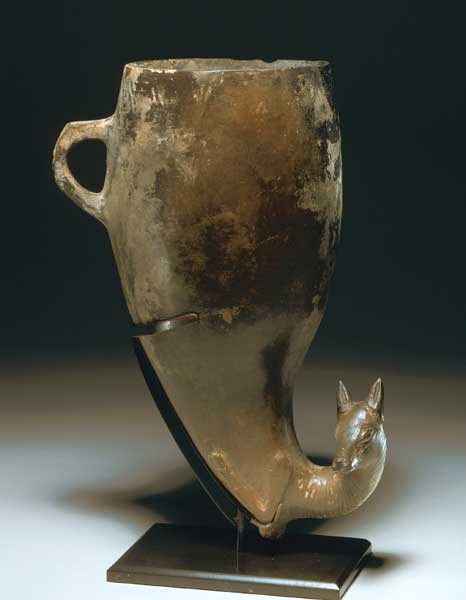Amlash Terracotta Rhyton, 900 BCE - 800 BCE
Terracotta
height 29.2 cm
height 11 1/2 in
height 11 1/2 in
X.0356
The Amlash culture is known almost exclusively through the archaeological material that has emerged in recent decades. We know little about the people themselves, other than the fact that they...
The Amlash culture is known almost exclusively through the archaeological material that has emerged in recent decades. We know little about the people themselves, other than the fact that they were highly skilled artists and artisans. Otherwise, it appears that this ancient culture once inhabited the mountainous regions bordering the Caspian Sea in the north of modern day Iran. According to the archaeological record, their culture appeared to reach its plateau during the 9th and 8th Centuries B.C. Although we are uncertain whether the population was native to the land or migrated from border regions, the subject matter of their art and pottery, which characteristically include themes relating to nature, is clearly linked to the art of their contemporary neighbors including the cultures of Luristan and Elam.
The word rhyton derives from the Greek verb meaning “to run through.” Paintings on the sides of Greek vases depict revelers using rhytons to aerate and drink wine. The wine was poured into the top of the vessel and came out from the animal-headed spout that emerges from the neck. This gorgeous burnished grey terracotta rhyton was created by the Amlash culture. During the 8th and 7th Centuries B.C., rhytons in the form of animal heads were extremely popular throughout Ancient Iran. No king or ruler would have been without a rhyton, and the leaders naturally competed with each other to have the most beautiful and luxurious examples. This magnificent rhyton features a wide body with a small handle that tapers into a curved neck. The spout has taken on the form of the head of a female Ibex or gazelle. The majesty of this creature has been captured by the artist, who created this representation with an amount of attention and detail that is normally reserved for portraits of nobility.
The word rhyton derives from the Greek verb meaning “to run through.” Paintings on the sides of Greek vases depict revelers using rhytons to aerate and drink wine. The wine was poured into the top of the vessel and came out from the animal-headed spout that emerges from the neck. This gorgeous burnished grey terracotta rhyton was created by the Amlash culture. During the 8th and 7th Centuries B.C., rhytons in the form of animal heads were extremely popular throughout Ancient Iran. No king or ruler would have been without a rhyton, and the leaders naturally competed with each other to have the most beautiful and luxurious examples. This magnificent rhyton features a wide body with a small handle that tapers into a curved neck. The spout has taken on the form of the head of a female Ibex or gazelle. The majesty of this creature has been captured by the artist, who created this representation with an amount of attention and detail that is normally reserved for portraits of nobility.



